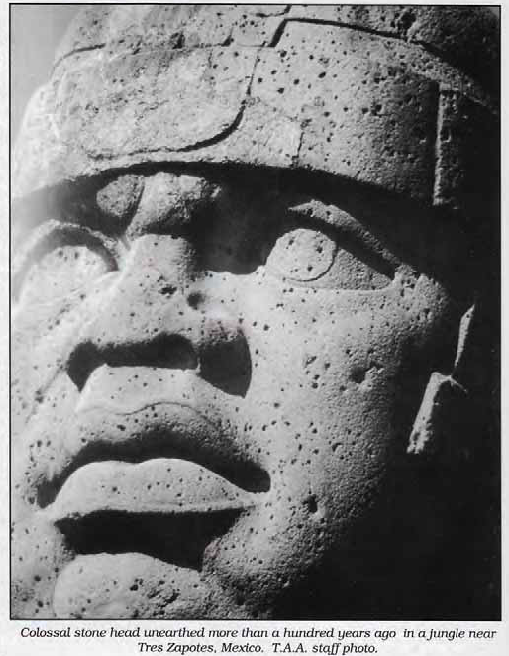by Cyclone Covey, DFMES, Wake Forest University, Winston-Salem, N.C.
Originally published in The Midwestern Epigraphic Journal, Volume 20, 2006.
Comments on: Lawrence F. Athy, “Foreign Influences on the Priesthood & Nobility of Precolumbian America,” ESOP XVII (1983), 106-120 & “Beards in North America Before Columbus,” XIX (1990), 169-175.
THESE SEMINAL ARTICLES did not receive proper deliberation during the lifetime of Larry Athy, a deeply thoughtful genleman best known as one of the world’s 3 leading authorities on Comalcalco (with Neil Steede & Frank Reynolds) who declared Comalcalco not the most spectacular bust most important precolumbian site. Whether so, its inscribed bricks in many languages besides Mayan confirmed foreign influences. He notably demonstrated (at the 1988 ISAC Conference) a startling parallel of Aegean and precolumbian Mexican art, apparently confirming Olmec beards transatlantic. As a native of Ponca City, Okla. he knew Indians had virtually no facial hair, so conjectured goateed Olmec aristocrats including shamans Europoid.
Though the Mexican government decreed all precolumbian Mexican art & artifacts indigenous, Athy knew that evolution did not start at a height, conjecturing already-full-blown Olmec could have resulted from 100 men in 4 ships but probably many more men and ships visiting Veracruz and departing without establishing colonies or trade-after native women favored them, thus Caucasoid and Negroid descendants. Native Indian women, we know from Spanish colonial experience, preferred Black husbands because they treated women better. Athy neglected to note that the famous gigantic Negro Olmec heads beardless, thus Blacks unlikely co-responsible for Olmec beards.
Expressly discounting an Asian source, extrapolating from Indians of his acquaintance, he seemed unaware that while Chinese were not typically bearded, there were bearded Chinese immemorially, especially savants, shamans, and emperors. Neither did beards typify Mongols. Yet Mongol emperors also had beards, including Yuan & Ming dynasties. Genghis Khan was described bearded. Olmec sculptures indicate beards, however, as uncommon in Mexico as in China and Mongolia. The Shang empire stretched a thousand miles all the way to Gansu encompassing half-Caucasoid Turks and Caucasoid Tocharians (Scythian/Sogdian Indo-Iranian & Italo-Celtic Yuchis), whereas Asians migrating to America in remote antiquity who sired the uniform population of medieval and modern Mexico evidently hailed from coastal South China.
With Mike Xu’s 1996 decisive detection of Olmec epigraphy as oracle-bone Chinese it became clear that Olmec was a transfer of Shang civilization probably calling itself Yin as in China, not misapplied Olmec, climaxing with refugees on a vast scale at fall of the Shang capital Anyang to the Duke of Zhou a few years either before or after 1100 B.C. We must seek Olmec beards from Asia after all but a different population from Asian predecessors whom Bronze Shang migrants found in stagnating Neolithic fishing villages.
Shang refugees had not only not departed Veracruz and Tabasco but stayed and established long-range trade via frontier bases like Chalcatzingo. Bearded Carthaginians certainly reached Mexico but not til Olmec had lost Mexican dominance to Teotihuacan, so could not account for centuries’ earlier Olmec beards. Carthaginians did also establish colonies and trade, centrally at Maya Comalcalco.
As to Aegean/Mexican resemblance, we would now have to call it convergence of geometric mentalities from different derivations–Anatolian-Minoan-Mycenaean agricultural villages on one hand and Yangshaoan-Longshon-Xia-Shang agricultural villages on the other, both religiously preoccupied with snakes, which J.J. White perceives universally signify earth-ancestral identification.
What Athy permanently demonstrated in the face of standard dogma was nonindigenous origin of Mexican high culture. “It is time” he concluded, “for archaeologists to protect their credibility, to speak out for the facts and abandon politics” [“Beards in North America” 173]. (Not only archaeologists, we must add.) He died in Houston Jan. 24, 2004 at 76.
In a later letter:
On beards again, I forgot to take along an ivory figuring of a traditional savant Bonnie brought back from China. The old man has a beard reaching to his ankles. Bonnie didn’t remember seeing any beards in China, but ancient and medieval Chinese art shows them. I suspect Chinese beards were not ethnic Chinese. In the Mongol epoch 1280-1368 an estimated million Mongols resided in China, many of these not Mongols but Uighgurs, Turks, Tungusese, et al. I mentioned Genghis Khan had a beard. So did Atilla the Hun. The Ming epoch 1368-1644 was officially native but its peasant-monk founder Ju-Yuan-jang had a Mongol middle name. Manchus 1644-1911 were Tungus, whom we know essentially Turkish whose women on the Amur provided involuntary wives of the escaped Xi-Xia soldiers. Our Indians evidently derive from beardless stock.
Photos courtesy of Ancient American Magazine & The Midwestern Epigraphic Society.
For more information:
http://alternativearchaeology.jigsy.com/olmec-faces-phoenician-beards-and-african-lips
http://ancientaliensdebunked.com/mystery-solved-olmecs-and-transoceanic-contact/





